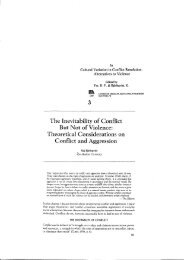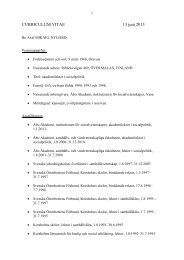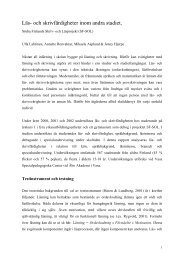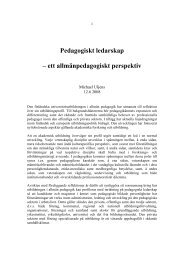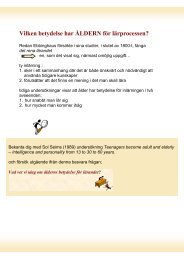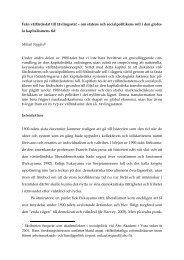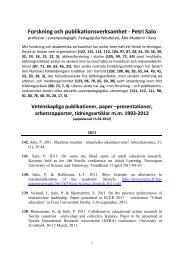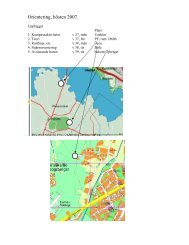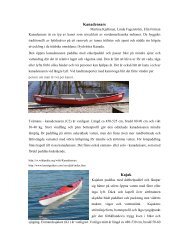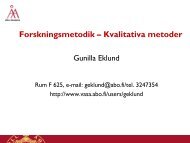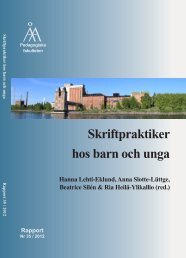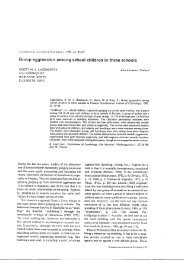Parties, Candidates and Citizens On-Line - Åbo Akademi
Parties, Candidates and Citizens On-Line - Åbo Akademi
Parties, Candidates and Citizens On-Line - Åbo Akademi
You also want an ePaper? Increase the reach of your titles
YUMPU automatically turns print PDFs into web optimized ePapers that Google loves.
Table 3. Party questionnaire clusters: the associated parties<br />
Party Clusters<br />
I II<br />
Social Democratic Party X<br />
Centre Party X<br />
National Coalition Party X<br />
Swedish People's Party X<br />
Christian Democrats X<br />
Green League X<br />
Left-Wing Alliance X<br />
True Finns X<br />
Alternative People X<br />
Union for free Finl<strong>and</strong> X<br />
For the Poor X<br />
Four circumstances concerning political parties, – i.e. party goals, organizational culture<br />
<strong>and</strong> tradition, size <strong>and</strong> resources <strong>and</strong> type of voters – were discussed in the theoretical<br />
backdrop. Could the party clusters presented in Table 3 be traced to any of these partyrelated<br />
circumstances?<br />
Put bluntly, the answer to the question appears to be no. The parties in cluster I<br />
appear to have no common denominator in any of the theoretically derived<br />
circumstances. Obviously, party goals are very difficult to establish objectively, one party<br />
usually contains several goals (cf. Kitchelt 2001, 276; Strom 1990, 570). Tentatively,<br />
though, the patterns in cluster I do not seem to have appeared due to any specific party<br />
goal. Arguably, all modern Finnish parties stress vote maximization (Nousiainen 1998,<br />
59). Nonetheless, the parties in cluster I show variations in their other goals. Even though<br />
the Centre Party <strong>and</strong> NCP are likely to primarily stress vote maximization, they have often<br />
been part of the government ‘cartel’ <strong>and</strong> also emphasize office maximization (cf. Katz &<br />
Mair 1995, 5; Sundberg 1996, 16). The Green League <strong>and</strong> the LWA stress internal<br />
democracy <strong>and</strong> cohesion (Zilliacus 2001, 39). Also, even though little is known<br />
concerning the goals of the remaining three parties in cluster I, the Union for Free<br />
Finl<strong>and</strong> <strong>and</strong> For the Poor, appear to be policy-driven parties focusing on an anti-EU <strong>and</strong><br />
social policy agenda respectively.<br />
The parties in cluster I also display a mix of party organization, ranging from the<br />
Centre Party with a history of mass-party organization, to the NCP which has a cadre-like<br />
tradition (cf. Sundberg 1996, 16-9; Nousiainen 1998, 59-60; Zilliacus 2001, 28-30).<br />
Measured in share of votes in the last election (cf. Norris 2003, 28), a fair enough measure<br />
of party size in Finl<strong>and</strong> as the parties receive part of their organizational funding on the<br />
basis of their electoral success (Djupsund 1990, 20; Sundberg 1996, 150), the parties in<br />
cluster I also differ very much in size <strong>and</strong> resource strength. Furthermore, historically,<br />
these parties have very different types of voters (Pesonen & Sänkiaho 1979, 120-125;<br />
97



